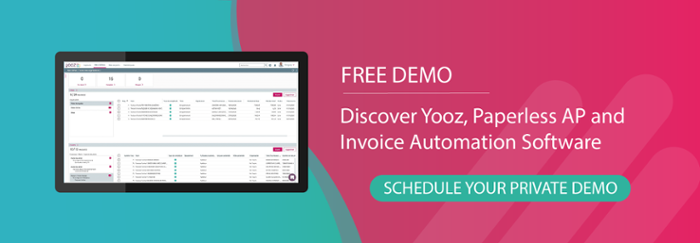Invoicing: the way by which a document is given to a buyer by the seller in order to collect payment. Just like with all financial processes, the way that it is done - and the accuracy - play a major part in the success of a business.
That being said, how does one process invoices with greater accuracy, efficiency, and speed? This is a question that has plagued accountants ever since the first invoice was filed. It isn’t simply a question of traditional Accounts Payable (AP) and Receivable being unnecessarily time-consuming and prone to error; finance teams want the ability to devote more time for valuable tasks that add tangible value to the business.
The most obvious answer is to streamline the invoice process. Before technology improvements this often meant the company would hire additional staff to absorb extra work. However, companies often didn’t – and still don’t – always want to take that route as it can be both costly and merely a short-term solution. Plus, with a global economy that includes businesses with multiple locations often far apart, hiring more staff didn’t necessarily streamline (and therefore speed up) the invoice process.
All these concerns can now be easily addressed in today’s digital-first era using technology such as automated invoice processing. But to fully understand this, we need to pick apart the accounting system honestly and precisely.
The accounting department up against the wall of growth
Most companies manage their accounting internally on a small scale until they run up against the wall created by growth. People enter invoices one at a time, validate them, approve payment, classify them, etc. Processing can take 3 to 5 weeks (and sometimes more) just to process an invoice. Now imagine larger companies that regularly need to process lots of invoices, even thousands. Weeks can easily turn into months.
More invoices more time required to process, and then? Late payments accumulate and penalties build up, not to mention an increase in duplicates, risk of disputes, and excess paperwork. The result is that accountants spend nearly one third of their time handling late payments. This activity is neither interesting for them nor productive for the company. In fact, quite the contrary. Nor does an ineffective process benefit the vendor.

Analyzing the full cycle of accounts payable
After all, for any business the accounts payable process starts and ends with the vendor. Let's examine this in more detail.
After ordering and receiving the product or service, a pending account payable can be drafted based on the agreed terms between company and vendor. For services rendered, the vendor will then send through a receipt, increasing the credit balance. The accounting department needs to cross-reference this receipt against the received report or purchase order, ensuring that the information, prices, and quantities on each record are identical to those on the receipt and invoice. This serves to eliminate any duplicates or fraudulent attempts. Then, if everything matches, an invoice for payment is set to be authorized.
Simple, right? Appearances are deceiving. The accounts payable invoice process workflow and payment can be much more time-consuming and complicated.
Consider the manual processing route. When you add in the human factor accountancy can quickly change from “how to process invoices in accounts payable accurately” to “where did that invoice disappear to?” or “I calculated and recalculated the payment numbers - how did the error creep into the processing?”! This is because traditional AP invoice processing relies on humans being able to input data correctly, each and every time. Even just the journey from printer to filing cabinet can be rife with danger, and many an invoice has slipped through the cracks (or disappeared through an open window) to the detriment of client-vendor relationships.
Luckily, there are viable software options that remove human steps, errors, and disappearing paper invoices from the processing equation (which is good for both business and sanity).
Impressive productivity improvements
By leveraging today's technology and in particular smart automation techniques, a business can streamline their invoice process and save a significant amount of time, all while experiencing a rapid Return on Investment (ROI). In fact, studies show that companies can make their overall invoice processing cycle time approximately 2 to 5 times faster.
Time and ROI aren't the only benefits. Faster and more efficient automated invoice processing helps limit delays or lateness, reduce disputes, and decrease time spent answering supplier questions. This leads to even further productivity gains for the business. In other words, with the right tools in place, finance departments can improve their efficiency considerably and take on increased business activity over the long run without having to resort to staff increases.
How to process invoices using an accounts payable automation platform
Using artificial intelligence and cloud-based technology, modern AP automation streamlines and optimizes the invoice process to make accountants’ and management’s lives easier. A best-in-class service provider will be able to deliver a solution that automates data entry and invoice validation through multichannel capture, from all document types and in multiple formats.
So, what makes a successful workflow? We’re glad you asked:
- Manual data capture (and entire invoice process) is time-consuming and inevitably leads to mistakes. With a digital process, clerical errors are quickly identified and fixed.
- Upon entry, invoices must be categorized by format, such as PDF or XML. By automating the process, files are sorted without human intervention.
- The invoice approval process is multifaceted and involves many people, which can lead to delays and incorrect invoice routing if done manually. An automated process removes approval bottlenecks and automatically routes the correct invoice to the right person.
- A digital record is kept that tracks the invoice through each stage of the process. This information is accessible at any time, from any place, and any device.
Also, don't forget that by eliminating the use of a paper-based process the company is able to save additional time (there is no manual transfer of documents, need to file, or need to research through files), cost (obviously everything having to do with paper but also that for physical storage space), and even machine maintenance.
The truth is that a modern business cannot afford to be weighed down by high processing costs, lack of visibility, lost documents, or the absence of a reliable audit trail that can help management get to the bottom of things. It costs £110 to search for a document and £200 to recreate it, and when you consider that 7.5% of documents handled by any given company are lost, the disadvantages of manual AP become clear.
Can you afford not to go with AP automation?
Accounts Payable Automation is transforming the accounting industry. Thanks to cloud-based technology what used to be a physically bulky and expensive investment has become accessible to even the smallest business. Companies can simply pay for what they use on a system that is easily scalable and become more competitive with a system that takes the same amount of time to digitally communicate across the street or the ocean. Bills, invoices, money owed... All these are easily incorporated into the automation process.
This means that any business now can turn their accounts payable departments into innovative, cost-efficient profit centers. Equally important, it creates a happier work environment as employees no longer are subjected to routine, ongoing, and occasionally overwhelming tasks and can instead add other meaningful, valuable contributions to the company.
Implementing digital-first AP automation is not a leap of faith. It’s a considered decision that will transform your accounts payable department by reducing costs, incentivizing employees, and optimizing the invoicing process. The key is to act.
Can you afford to go with AP automation? The real question is actually can you not afford to do it?

.jpg)






